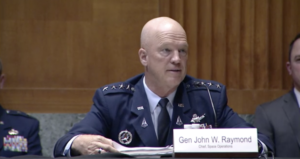“We need more smaller, easier to defend satellites that have redundancy. That’s the biggest priority for me within the Space Force budget,” Rep. Adam Smith (D-Wash.) said June 29 on a Defense Writers Group video conference.
Smith said the military needs reliable and cyber secure information systems and those systems depend on satellites. The Space Force, he noted, is responsible for the “survivability of our satellites and our command and control systems.”
The satellites that the Pentagon has relied on for decades have to be replaced with more resilient systems, he said.
“That’s where we are a little bit vulnerable right now, because for decades we have built very large, very sophisticated systems,” Smith added. “It’s a bit of an overstatement to say they are a single point of failure, but it’s not that big of an overstatement.”
This has to be the “primary objective of the Space Force going forward,” Smith said. “We need to build greater redundancy and greater survivability. What I think the Space Force can bring is to look at the whole architecture and say ‘how do we make sure that this keeps working no matter what happens.’”
Smith said he could not predict what space weapons Russia or China will deploy to target U.S. satellites. Whatever happens, he said, “we need to be ready for it, we need to be able to protect our systems and we need to be able to deter our adversaries from attacking them in the first place.”
The issue of Space Force investments in next-generation systems came up during a June 16 HASC hearing on the Department of the Air Force’s budget request for fiscal year 2022.
The chief of space operations of the Space Force Gen. John Raymond agreed with Smith.
“We have to shift to a new architecture,” Raymond said at the hearing. “The capabilities that we have in space today are exquisite, they’re the world’s best. They’re expensive, but they’re not defendable. We have to shift to a more diversified architecture and we have to shift to an architecture that has resiliency built into it and not bolted on as an afterthought.”
Raymond said the Space Force is standing up a Space Warfighting Analysis Center to focus on planning and budgeting for the future space architecture. The Space Force is seeking $6.2 million in 2022 for the SWAC to “conduct analysis, modeling, wargaming and experimentation to create operational concepts and force design guidance for U.S. Space Force missions.”



